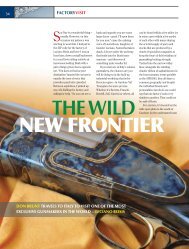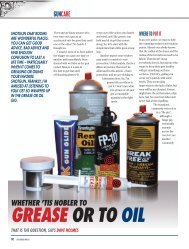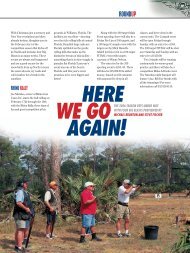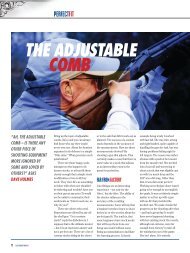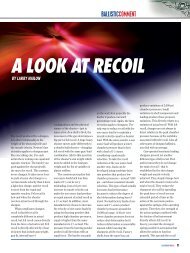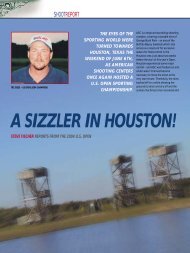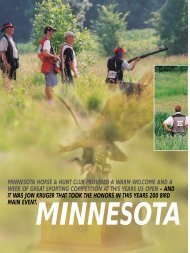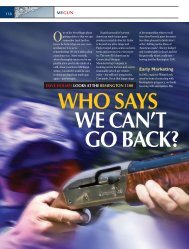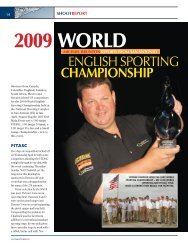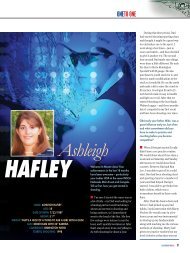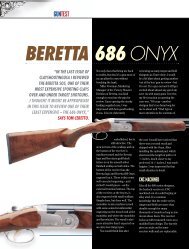The World Sporting Championship - Clay Shooting USA
The World Sporting Championship - Clay Shooting USA
The World Sporting Championship - Clay Shooting USA
Create successful ePaper yourself
Turn your PDF publications into a flip-book with our unique Google optimized e-Paper software.
WORLD SPORTINGCHAMPIONSHIP<br />
<strong>The</strong> <strong>World</strong> <strong>Sporting</strong> <strong>Championship</strong><br />
alternates between the US and<br />
England. <strong>The</strong> 2006 event was held<br />
at the Somerley Estate in the south<br />
of England by kind permission of<br />
Lord Normanton and sponsored by<br />
Tarmac. Targets for each of the<br />
100 bird 14 station Red and Blue<br />
courses were set by <strong>World</strong><br />
Champion, Richard Faulds.<br />
<strong>The</strong> Blue course was set up<br />
along a central ride that snaked it’s<br />
way through forestry, while the Red<br />
course offered more open terrain<br />
for stations 1 to 3, 7 and 8, that<br />
delivered greater target variety.<br />
Clearly Faulds had put a great<br />
deal of hard work into his course<br />
design – first visiting the venue<br />
back in February – and the degree<br />
of difficulty was about right for<br />
such a blue ribbon event.<br />
<strong>The</strong> spectacular views and<br />
terrain may well have been a<br />
double-edged sword for Faulds, in<br />
that both courses were among<br />
woodland that probably constrained<br />
target variety. Red course included<br />
three battues, one rabbit and four<br />
midis while the Blue course included<br />
two rabbits – one at only 20 ft on<br />
station 9 – three battues and four<br />
midis, leaving an emphasis on<br />
quartering presentations.<br />
Most shooters found it difficult<br />
to build good scores on either course<br />
– the CPSA rotation system of two<br />
flights and double squads on each<br />
station per course per day just doesn’t<br />
work. Hold ups were inevitable and<br />
on the first flights of the first day<br />
significant breakdowns with delays<br />
of an hour on some stations saw<br />
competitors taking up to five hours to<br />
complete 100 targets. Concentrating<br />
and maintaining focus was no easy<br />
task that first morning.<br />
By Saturday afternoon – and on<br />
through Sunday – breakdowns and<br />
delays were minimized and the event<br />
ran smoothly, though hold ups on<br />
certain stations was still evident.<br />
Both courses had a cluster of three<br />
pair stations (Red 12, 13, 13A and 1<br />
and Blue 22, 23 and 24) that saw<br />
shooters move through quickly but<br />
then bottleneck on the next four<br />
pair station – and with double<br />
squadding the result was back-ups<br />
of four squads or more.<br />
AT LEFT, LONG HOLD UPS DID NOT MAKE<br />
IT EASY TO HOLD CONCENTRATION AND<br />
FOCUS. ABOVE: ANTHONY MATARESE JNR<br />
– ANOTHER TARGET AWAY!<br />
DAY ONE<br />
Despite the breakdowns and<br />
delays of the first morning, each<br />
course demanded that competitors<br />
were on their top game. Angles<br />
were deceptive, the majority of<br />
targets were fast and, when among<br />
the trees, the selection of the right<br />
break point was essential.<br />
George Digweed’s 93 was<br />
matched by Mark Marshall after<br />
day one – the only competitors<br />
from a field of 672 that broke the<br />
90 barrier. Bill McGuire (88) was<br />
the top scoring American. “I was<br />
four or five light but tomorrow’s<br />
another day” said McGuire. Cory<br />
CLAYSHOOTING<strong>USA</strong> 9



